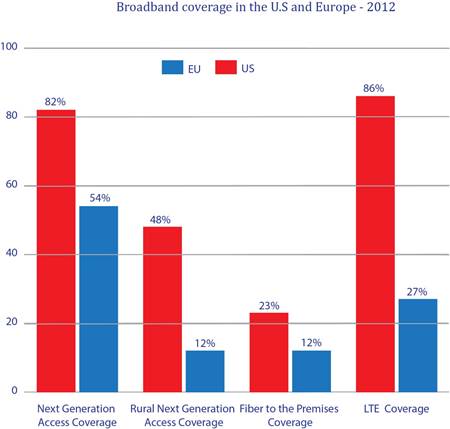Written by Mar Negreiro
The high speed broadband gap between the EU and U.S is widening as the U.S performs better than the EU in most broadband metrics: this is the main message from the publication: U.S. vs. European Broadband Deployment: What Do the Data Say?, presented by its author in a meeting at the think-tank CEPS in Brussels last October. This comprehensive study compiles a wide range of broadband indicators and comparisons, looking among other criteria at deployment levels in urban and rural areas, the type of technology, investment levels, broadband speeds, prices and other relevant policy indicators, with the U.S leading on most. Some of the main data comparisons that highlight this gap include:

-
A far greater percentage of U.S households have access to Next Generation Access (NGA) networks (25 Mbps) than in Europe. This gap exists both on coverage for the entire nation (82% vs. 54%) and when looking at rural areas (48% vs. 12%): showing that there is a new type of digital divide emerging in rural areas for fast broadband.
-
The U.S broadband is cheaper than European broadband for all speed tiers below 12 Mbps. However U.S broadband is more expensive for higher speed tiers: according to the author, this higher cost relates to the fact that U.S internet users on average consume 50% more bandwidth than their European counterparts.
-
The U.S broadband industry has invested more than two times more capital per household than the European broadband industry every year from 2007 to 2012.
Comparing different selected national policy case studies and literature reviews, the author concludes that broadband coverage is best promoted by a flexible approach which focuses on several technologies rather than exclusively on a single approach, e.g. fibre.
Fast speed broadband deployment is considered paramount for Europe’s competitiveness: for this reason, the Digital Agenda for Europe has set up ambitious targets to boost ultra-fast broadband penetration. By 2020, there should be access to speeds of above 30 Mbps for all Europeans (currently at 54%) and internet subscriptions for connection above 100 Mbps for 50% or more of European households. Since only 3% of households were connected at speeds of 100 Mbps in 2013, much effort is still needed to reach these targets.
Narrowing the current EU fast speed broadband gap requires that the EC mobilise and implement its policy instruments for the sector. Among the EU support efforts there are a number of Broadband Financing and Funding mechanisms (such as the Connecting Europe Facility), legislation on its way (i.e. the Connected Continent legislative package) and actions for increased mobile broadband availability.
Net neutrality also remains a key issue in both sides of the Atlantic, one that affects Broadband investment levels and its quality: in the U.S, President Obama has recently asked the FCC to put in place the strongest possible rules to support it and this is also being considered in Europe ‘s current net neutrality proposals.
Creating a connected digital single market is one of the ten priorities for the new EC and this relies on more fast-speed broadband being available to everyone across Europe. Without it, slower progress can be expected in the EU while other countries continue growing their digital economy.








This is a very one-sided blog summary of the report. For balance, particularly given the enormous differential in PPP in Southern and Eastern Europe, see http://www.ectaportal.com/en/REPORTS/Reports-Studies/Explaining-Telecoms-Performance-across-the-EU/
Thank you for the comment and the link to your publication. The blog post features analysis and data that the author selected and presented at the CEPS event mentioned: Indeed this very comprehensive publication includes much more analyses and data than those presented by him and readers who want an in-depth view should refer to the full publication.
[…] in many categories of broadband speed, adoption, penetration in cities and rural areas according to EU lagging behind in fast broadband from the European Parliamentary Research Service.Tthe Internet Monitor 2014 looks back on the year […]
[…] Errors in WindowsTransformational ImagemakingThe Controversial Intersection of Faith and ScienceEU lagging behind in fast broadbandbody { background: […]